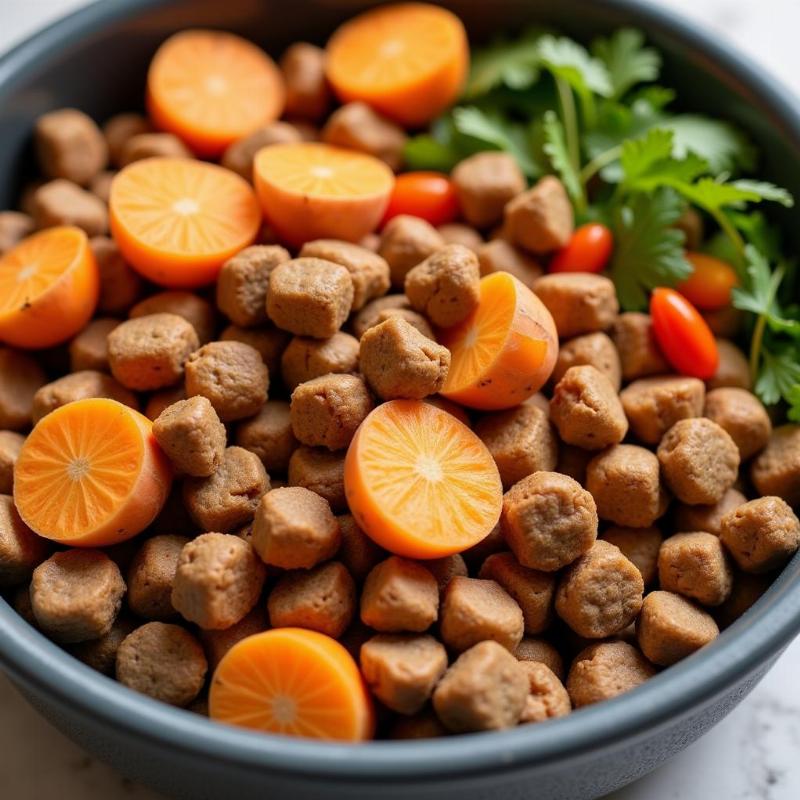Grain and gluten free dog food has become increasingly popular among pet owners in the US. Many are seeking this specialized diet for their canine companions due to concerns about allergies, sensitivities, or simply a desire to provide what they perceive as a healthier option. This guide will delve into the benefits, drawbacks, and important considerations when choosing grain and gluten free dog food for your furry friend.
Understanding the Need for Grain and Gluten Free Dog Food
While grains provide carbohydrates for energy, some dogs experience adverse reactions to them. Gluten, a protein found in wheat, barley, and rye, can trigger digestive issues and skin problems in sensitive dogs. Common symptoms include itching, redness, gastrointestinal upset, and even behavioral changes. If your dog exhibits these symptoms, a grain and gluten free diet may be the solution.
 Grain-free dog food ingredients
Grain-free dog food ingredients
Benefits of a Grain and Gluten Free Diet for Dogs
Eliminating grains and gluten can significantly improve a dog’s health. For dogs with sensitivities, switching to a grain and gluten free diet can alleviate digestive problems, leading to improved stool quality and reduced gas. Skin allergies can also clear up, resulting in less itching and healthier skin and coat.
Choosing the Right Grain and Gluten Free Dog Food
Not all grain and gluten free dog foods are created equal. Look for high-quality options that meet the Association of American Feed Control Officials (AAFCO) standards. These standards ensure the food contains the necessary nutrients for your dog’s life stage. Check the ingredient list carefully, ensuring the first few ingredients are high-quality protein sources like meat or fish. Avoid foods with fillers, artificial colors, and preservatives.
Deciphering Ingredient Lists: What to Look For and What to Avoid
Understanding dog food labels can be challenging. Look for whole, recognizable ingredients. Sweet potatoes, chickpeas, lentils, and vegetables are excellent alternatives to grains. Avoid by-products, generic meat meals, and artificial additives. Consulting with your veterinarian can help you choose the best option for your dog’s specific needs.
“Always consult with your veterinarian before making any significant dietary changes for your dog,” advises Dr. Emily Carter, DVM, a leading veterinary nutritionist in New York. “They can help determine if a grain and gluten free diet is truly necessary and guide you toward the best food choices.”
Transitioning to Grain and Gluten Free Dog Food
Introduce the new food gradually. Start by mixing a small amount of the grain and gluten free food with your dog’s current food, gradually increasing the proportion over several days. This will help your dog adjust to the new diet and minimize digestive upset.
Addressing Common Concerns About Grain and Gluten Free Dog Food
Some pet owners worry about the cost of grain and gluten free dog food. While it can be more expensive than traditional dog food, the health benefits for sensitive dogs often outweigh the additional cost. It’s crucial to prioritize quality ingredients and complete nutrition over price.
“While cost is a factor for many pet owners, investing in high-quality, grain-free food can ultimately save money on vet bills in the long run,” notes Dr. Patricia Miller, DVM, a veterinary dermatologist practicing in California. “Addressing allergies and sensitivities early on can prevent more serious health problems down the line.”
Conclusion: Prioritizing Your Dog’s Health with Grain and Gluten Free Food
Choosing grain and gluten free dog food can significantly improve the health and well-being of dogs with sensitivities. By understanding the benefits, choosing high-quality options, and transitioning gradually, you can ensure your dog thrives on this specialized diet. Remember to consult with your veterinarian to determine the best course of action for your furry friend.
FAQ:
- How do I know if my dog needs grain and gluten free food? Consult with your veterinarian if your dog exhibits symptoms like itching, digestive upset, or skin problems.
- What are good alternatives to grains in dog food? Sweet potatoes, chickpeas, lentils, and vegetables are excellent alternatives.
- Is grain and gluten free dog food more expensive? It can be, but the health benefits often justify the cost.
- How do I transition my dog to a new food? Gradually mix the new food with the old food over several days.
- Are there any potential downsides to grain and gluten free dog food? Some lower-quality brands might lack essential nutrients, so choosing a high-quality option is crucial.
- What should I look for on the ingredient list? Prioritize whole, recognizable ingredients and avoid fillers, by-products, and artificial additives.
- Where can I buy grain and gluten free dog food? Specialty pet stores, online retailers, and some veterinary clinics carry these diets.
Beautdogs.us is your premier online resource for all things dog-related in the US. We offer comprehensive and trustworthy information on dog breeds, care, and products, catering to both new and experienced dog owners. From breed-specific advice to expert tips on nutrition and training, Beautdogs.us empowers you to provide the best possible care for your furry companion. Contact us at [email protected] or call us at +1 501-555-7529 for personalized advice.